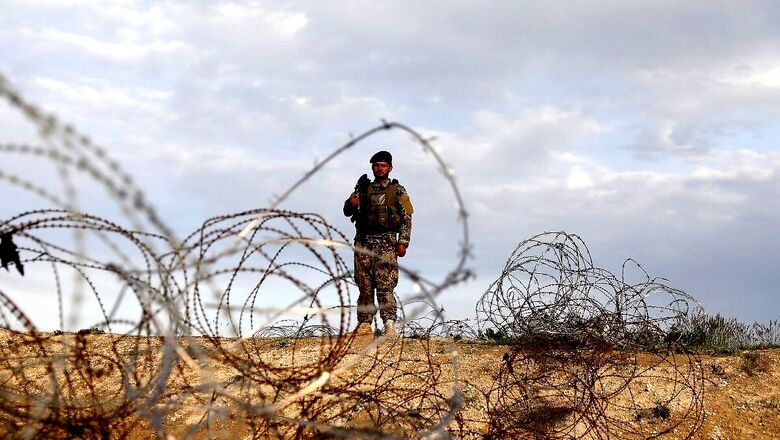
views
The Taliban version of blitzkrieg in Afghanistan is being watched with ‘shock and awe’, not just in Western capitals and regional countries, but also in Pakistan, which for two decades has supported and sponsored the Taliban war effort. Since May 1 when the US troops started their withdrawal, the Taliban have doubled the number of districts under their control. The districts have fallen like nine pins because, in most cases, the resistance to the Taliban advance is either half-hearted or non-existent. It is almost as if the Afghan National Army (ANA) is crumbling before the Taliban, without so much as putting up a fight.
The string of defeats, setbacks and reversals have shattered the already low morale of the troops who are abjectly surrendering before the Taliban. The speed at which the Taliban are scoring gains has prompted the US intelligence community to re-assess the ability of the Afghan government to survive for more than six months after the US withdrawal is completed. Earlier, it was believed that the ANA will be able to hold its own against the Taliban for at least a couple of years. Now, however, no one is willing to place any bets on the ANA, and there is some chatter that the Afghan government could collapse even within weeks of the US exit.
The tell-tale signs of the roof collapsing are palpable on the streets what with people desperately trying to get out while they still can. It wasn’t like this even at the time when the last Soviet troops exited from Afghanistan in early 1989. Back then, it was quite an anti-climax because, much to the disappointment of the Western media, there were none of the scenes of triumphant ‘mujahideen’ entering Kabul the day after the Soviets left. The Najibullah government held out for nearly three years and finally collapsed when the successor state of the Soviet Union was no longer able to support it with military supplies and monetary assistance.
This time, however, there is real panic and people seem to be expecting the sky to fall suddenly. What has added to sense of gloom and doom is the fact that the Taliban are making advances not just in their traditional strongholds in the South and East of the country, but also in the North and West. Some of these provinces in the North were redoubts of the anti-Taliban forces and had held out even when the Taliban had captured 90 per cent of the country in the late 1990s. And yet, today they are as threatened and vulnerable as any other part of Afghanistan.
This didn’t happen overnight. The Taliban have been slowly and deliberately expanding their footprint in the North for years. From at least around 2014, there has been a steady rise in Taliban action in some of the Northern provinces. This, it appears, was part of the grand strategy to not repeat the mistake that it made in the 1990s of leaving the north for the last. This time, the Taliban seem to have decided that they will simultaneously increase their presence in both the West and North even as they continued to expand their complete control over provinces in the South and East.
It now clear that the Taliban were preparing for the day when the US forces would withdraw, and they would move in for the kill. The fall of Kunduz in 2015 should have served as a wake-up call for the government forces. But the fact that the Taliban didn’t hold on to the city and vacated it within a couple of days added to the complacency that seemed to have become the leitmotif of the Afghan security forces.
Even as late as 2019, government officials saw the increasing activity of Taliban in the North as nothing more than a ploy to improve their negotiating position.
The denial of the ever-expanding footprint of the Taliban was compounded by a touching belief that the Americans will never abandon Afghanistan. There was also the misplaced confidence that the Taliban will not be able to sweep through Afghanistan like they did in the 1990s. It wasn’t only the Afghan government that was guilty of this; members of the international community, including the Americans and their military kept painting a fairly rosy, and entirely misleading, picture of the ground situation in Afghanistan.
Even now, at this late stage of the war, the statements coming from the Americans are almost surreal: Secretary of State Antony Blinken recently said that the US is “assessing” if Taliban are serious about ending the conflict in Afghanistan; the US commander Gen Austin Miller is still talking of a political solution to end the war and how a civil war will result if the current rise in violence continues. Seriously? After two decades, the US is still assessing Taliban’s intentions? And, the US commander can’t see that Afghanistan has been in the throes of a civil war for more than a decade now, and that the political solution is nothing but a mirage, more so now that the Taliban are more confident than ever before that they are on the verge of complete victory?
Is the ANA Capable of Standing up to the Taliban?
It isn’t as if ANA can’t fight or doesn’t have the weapons to fight; the trouble is that a lot of the ANA seem to have lost the will to fight. Otherwise, both in terms of numbers as well as in terms of equipment and training, the ANA is more than a match for the Taliban, on paper at least. It might not have the wherewithal to rout the Taliban, but it certainly has the muscle to fight the Taliban to a standstill. Some analysts still believe that all is not lost and that too much is being made of tactical retreats from “distant and isolated garrisons, where supply lines were stretched and which could not be protected without air power.” Militarily, this makes sense. But the problem is two-fold: One, these tactical withdrawals created an impression that the ANA is crumbling in the face of the Taliban onslaught and set in motion a domino effect with one garrison after another abjectly surrendering, giving the Taliban a huge psychological boost; two, it wasn’t just isolated garrisons but also some really strategic positions, districts and populations centres that fell to the Taliban.
To blame the spate of reverses suffered by ANA on the lack of close air support that the Americans used to provide is a bit of an overstretch. It isn’t as if the Taliban have air support. And even when the air support was available to the ANA, it wasn’t as if the Taliban were not notching up victories. This is not to deny that air support is a force multiplier. But if without air support the ground troops are unable to even put up a fight against an enemy that is less equipped and less trained than them, then air support alone will not turn the tide of war.
This raises serious questions over the utility of US plans for carrying out over-the-horizon operations in support of the Afghan forces. There are also questions about the practicality and cost effectiveness of such operations that will be launched not from bases in Pakistan or one of the Central Asian States but from bases in the Middle East or Aircraft Carriers stationed in the Arabian Sea. The distance the aircraft need to travel, the time it will take to reach the target, the extremely small window for attacking the target, and the cost involved, make the effectiveness of such support very doubtful. In the unlikely case the US gets a base, even two, in Pakistan or Central Asia, even that won’t change anything. After all, if having multiple bases inside Afghanistan didn’t work, what great military feat will become possible if the US operates from a base or two in Pakistan or Central Asia?
The writing on the wall is for all to see. Denial of the reality that is staring everyone in the face doesn’t solve the problem. All the talk of the real fighting will happen when Taliban close in on Kabul is just so much hot air. The fact is that the Taliban are steadily encircling Kabul. So far they haven’t really captured any significant population centre, but that is not because they can’t but because their strategy seems to be to keep squeezing and let these cities and towns capitulate without a fight. All apprehensions, or even hopes, of a prolonged civil war and stiff resistance seem to be nothing more than wishful thinking.
The only thing that has some chance of turning things around, or holding the Taliban for a few months, is a couple of significant victories that boost the morale of the Afghan troops. But where is that general or commander who can lead the troops? There doesn’t appear to be any serious effort to marshal the troops, regroup, consolidate the positions and fight back.
There have been a few attempts to retake lost areas. But other than a few of these see-saw battles which are not sustainable, the ANA has mostly been in headlong flight. The situation is so desperate that the government is now trying to raise local militias. Local warlords and communities are already trying to form their own small armies to resist the Taliban. At one level, this is a complete vote of no confidence in the ANA. At another level, it undermines whatever little authority is left with the Afghan state, which is now in an advanced state of meltdown. But the worst part of this desperate step is that it has virtually no chance of success. After all, if the most powerful military force in the world has suffered a humiliating defeat, and a much vaunted national army has crumbled, what chance do rag-tag militias have in stopping the Taliban?
Afghanistan is heading for an apocalypse. The only thing countries like India can do is to get out of denial mode about the imminent collapse of the Afghan state and brace for the wave of terrorism that will sweep through the region.
This article was first published on ORF.
Read all the Latest News, Breaking News and Coronavirus News here.




















Comments
0 comment